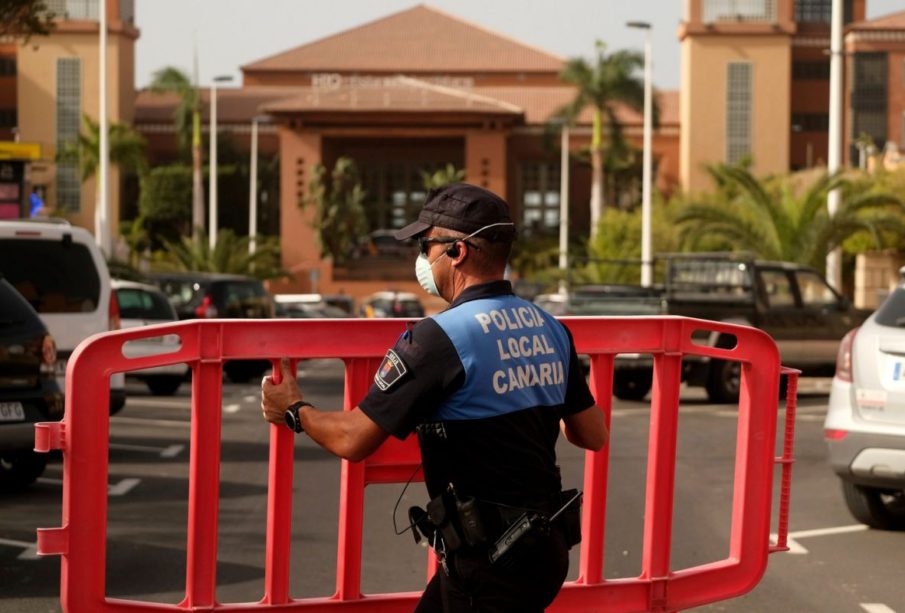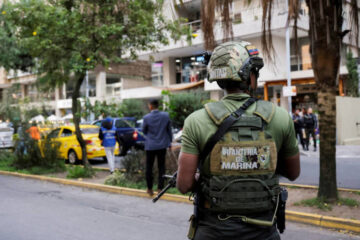Tenerife hotel with 1,000 guests in lockdown after Italian tests positive for coronavirus
 A Spanish police officer sets a barrier blocking the access to the H10 Costa Adeje Palace hotel in Tenerife - AP Photo
A Spanish police officer sets a barrier blocking the access to the H10 Costa Adeje Palace hotel in Tenerife - AP PhotoA tourist hotel in the Canary Islands was placed in quarantine Tuesday after an Italian doctor staying there tested positive for the new coronavirus, evidence that the epicenter of the outbreak in Europe is spreading with vacationing Italians.
The doctor hailed from Italy’s north, which has registered most of Italy’s 283 cases. He was placed in isolation at a clinic in Tenerife. The H10 Adeje Palace hotel was locked down, and its 1,000 tourists prevented from leaving, according to Spanish news media and town officials in Adeje.
The Canary Islands, an archipelago located around 100 kilometers (60 miles) west of the African coast, is a popular vacation destination that attracts Europeans year-round. Many Italians are vacationing this week as schools have a mid-winter break.
The virus also spread via tourists traveling within Italy, as the southern island of Sicily reported a positive case from a woman vacationing from Bergamo, in northern Lombardy. Two cases were also reported in Tuscany, well south of the epicenter.
Croatia, meanwhile, confirmed its first case — in a man who had been to Milan, the capital of Lombardy and Italy’s business hub.
Civil protection officials on Tuesday reported a large jump of cases in Italy, from 222 to 283. Seven people have died, all of them elderly people suffering from other ailments.
Italy has closed schools, museums and theaters and canceled Venice’s Carnival and Roman Catholic Masses in the two regions where clusters have formed — Lombardy and Veneto. Police and soldiers are enforcing quarantines around 10 towns in Lombardy and the epicenter of the Veneto cluster, Vo’Euganeo.
Premier Giuseppe Conte shocked Lombardy officials by taking to task the hospital in Codogno, southeast of Milan, where Italy’s first positive patient went on Feb. 18 with flu-like symptoms. The man was sent home, only to return a short time later with worsening conditions, at which point he was tested for the virus.
Many of Lombardy’s 200-plus positive tests have a traceable connection to the Codogno hospital, including several doctors and nurses, patients and relatives who visited them.
Conte told reporters that the Lombardy cluster grew “because of the hospital management that wasn’t completely proper according to the protocols that are recommended for these cases.”
“This surely contributed to the spread,” he said.
Lombardy’s chief health official, Giulio Gallera, expressed shock at Conte’s remarks and defended the region’s handling of the crisis.
“It’s offensive. It’s unacceptable,” Gallera said, noting that the man presented none of the main risk factors for the virus — travel to China or contact with an infected person — when he first went to the emergency room.
The man was eventually tested after doctors ascertained from his wife that he had met with someone who had recently returned from China. But officials have excluded that contact as the source of the outbreak since that person tested negative.
As officials worked to get ahead of the spread nationally, the reality of a two-week quarantine was setting in for residents of Italy’s “red zones” — the cluster of 10 towns in Lombardy and Veneto’s tiny Vo’Euganeo where residents were barred from leaving by police and army checkpoints.
“The concern is palpable, people are worried, partly because of what they hear on television, information, on social media,” said Davide Passerini, the mayor of Fombio, one of the 10 Lombardy towns under lockdown. “Life is like it is in other isolated villages: Everything is shut, people go out just to do their shopping.”
And they wait to see if they develop symptoms.
Italy initially tested anyone who came into contact with an infected person. But with the numbers growing and some supply issues with test kits, Italy’s national health system has revised its containment strategies.
People who live or have visited the quarantined areas, or who who have been in contact with positive cases, are advised to self-quarantine for two weeks. They are instructed to take their temperatures twice a day, and stay in touch with their doctors or the national health service via an overwhelmed toll-free number.
Only if they develop symptoms are they tested, most often by a team performing house calls to prevent hospitals and clinics being overwhelmed by possibly infected patients, said Elia Delmiglio, mayor of Casalpusterlengo, another of the 10 towns in Lombardy’s “red zone.”
“That’s why we are asking people to call only when they develop symptoms, so we are not forced to test everyone,” he said. The town — with more than 15,000 inhabitants — doesn’t have a working emergency room, but only a hospital mainly specialized in cancer patients, who are particularly at risk for contracting the virus.
“Local health structures are doing their best, but in some cases they were not ready to face such an emergency,” Delmiglio said.
In another hotbed of the virus outbreak — Veneto’s tiny town of Vo’Euganeo, which has 30 of Veneto’s 38 cases — local authorities were still planning to test all 3,300 residents and 600 acting hospital staff.
“I’m being optimistic and I feel well,” said resident Andrea Casalis, as he waited to be tested. “People continue to go out here and talk in the streets, but we try to keep some security distance.”
SOURCE: AP










